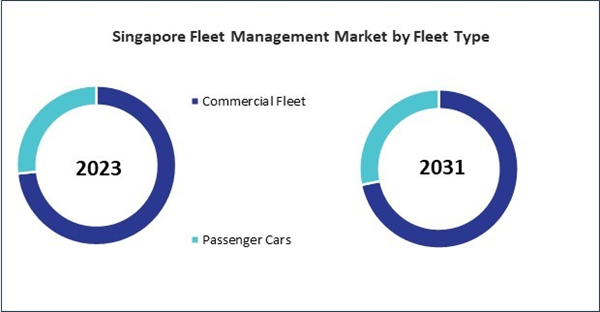The Asia Pacific Fleet Management Market is expected to witness market growth of 14.7% CAGR during the forecast period (2024-2031).
The China market dominated the Asia Pacific Fleet Management Market by country in 2023, and is expected to continue to be a dominant market till 2031; thereby, achieving a market value of $6.61 billion by 2031. The Japan market is registering a CAGR of 14.1% during 2024-2031. Additionally, the India market is expected to showcase a CAGR of 15.5% during 2024-2031.
Businesses are able to adhere to these regulations by utilizing these management systems, which offer real-time data on driver conduct, vehicle performance, and route adherence. For instance, North America's Electronic Logging Device (ELD) mandate requires commercial drivers to log their service hours electronically, a task efficiently managed by these management platforms.
The market for this management has also been impacted by the increasing focus on sustainability as well as environmental responsibility. Governments and businesses are focused on reducing carbon emissions and promoting eco-friendly practices. These management solutions contribute to these goals by optimizing routes to reduce fuel consumption, promoting fuel-efficient driving habits, and supporting the integration of electric vehicles (EVs) into fleets.
The Asia-Pacific market is rapidly expanding, driven by increasing industrialization, growing e-commerce penetration, and strong government policies focused on sustainability and efficiency. In China, the growth of transportation and logistics is a primary driver of fleet management adoption. As the world's largest e-commerce and manufacturing hub, China's logistics sector is expanding rapidly, requiring efficient fleet operations to manage complex supply chains. The Chinese government has introduced initiatives such as the Made in China 2025 strategy, which encourages the adoption of smart logistics and telematics in this management to improve efficiency and reduce emissions. Additionally, the government’s New Energy Vehicle (NEV) Policy promotes electric and hybrid fleet adoption, compelling logistics firms to integrate advanced these management solutions for EV tracking, battery management, and optimized charging infrastructure. Thus, as businesses scale operations and governments push for cleaner transportation alternatives, the demand for these management technologies is expected to soar, making Asia-Pacific a crucial market for the future of intelligent these management solutions.
The China market dominated the Asia Pacific Fleet Management Market by country in 2023, and is expected to continue to be a dominant market till 2031; thereby, achieving a market value of $6.61 billion by 2031. The Japan market is registering a CAGR of 14.1% during 2024-2031. Additionally, the India market is expected to showcase a CAGR of 15.5% during 2024-2031.
Businesses are able to adhere to these regulations by utilizing these management systems, which offer real-time data on driver conduct, vehicle performance, and route adherence. For instance, North America's Electronic Logging Device (ELD) mandate requires commercial drivers to log their service hours electronically, a task efficiently managed by these management platforms.
The market for this management has also been impacted by the increasing focus on sustainability as well as environmental responsibility. Governments and businesses are focused on reducing carbon emissions and promoting eco-friendly practices. These management solutions contribute to these goals by optimizing routes to reduce fuel consumption, promoting fuel-efficient driving habits, and supporting the integration of electric vehicles (EVs) into fleets.
The Asia-Pacific market is rapidly expanding, driven by increasing industrialization, growing e-commerce penetration, and strong government policies focused on sustainability and efficiency. In China, the growth of transportation and logistics is a primary driver of fleet management adoption. As the world's largest e-commerce and manufacturing hub, China's logistics sector is expanding rapidly, requiring efficient fleet operations to manage complex supply chains. The Chinese government has introduced initiatives such as the Made in China 2025 strategy, which encourages the adoption of smart logistics and telematics in this management to improve efficiency and reduce emissions. Additionally, the government’s New Energy Vehicle (NEV) Policy promotes electric and hybrid fleet adoption, compelling logistics firms to integrate advanced these management solutions for EV tracking, battery management, and optimized charging infrastructure. Thus, as businesses scale operations and governments push for cleaner transportation alternatives, the demand for these management technologies is expected to soar, making Asia-Pacific a crucial market for the future of intelligent these management solutions.
List of Key Companies Profiled
- AT&T Inc.
- Geotab, Inc.
- Wheels, LLC
- Masternaut Limited
- Omnitracs, LLC (Solera Holdings, Inc.)
- Trimble, Inc.
- WorkWave LLC
- Verizon Communications Inc.
- Samsara Inc.
- TomTom N.V.
Market Report Segmentation
By Component
- Solution
- Operation Management Solution
- Asset Management Solution
- Other Solution Type
- Services
- Managed Services
- Professional Services
By Fleet Type
- Commercial Fleet
- Passenger Cars
By Vertical
- Transportation & Logistics
- Retail
- Government
- Automotive
- Other Vertical
By Country
- China
- Japan
- India
- South Korea
- Singapore
- Malaysia
- Rest of Asia Pacific
Table of Contents
Chapter 1. Market Scope & Methodology
Chapter 2. Market at a Glance
Chapter 3. Market Overview
Chapter 4. Competition Analysis - Global
Chapter 5. Asia Pacific Fleet Management Market by Component
Chapter 6. Asia Pacific Fleet Management Market by Fleet Type
Chapter 7. Asia Pacific Fleet Management Market by Vertical
Chapter 8. Asia Pacific Fleet Management Market by Country
Chapter 9. Company Profiles
Companies Mentioned
- AT&T Inc.
- Geotab, Inc.
- Wheels, LLC
- Masternaut Limited
- Omnitracs, LLC (Solera Holdings, Inc.)
- Trimble, Inc.
- WorkWave LLC
- Verizon Communications Inc.
- Samsara Inc.
- TomTom N.V.
Methodology

LOADING...









